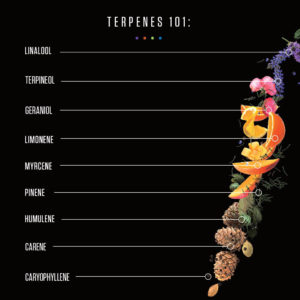 In cannabis, terpenes are found in the trichomes and are distinct to each strains profile.
In cannabis, terpenes are found in the trichomes and are distinct to each strains profile.
LINALOOL: most commonly found in lavender and is regularly used as a relaxation tool because of its anti-anxiety and stress reducing properties.
TERPINEOL: with its pleasant floral aroma, terpineol is shown to have relaxing effects.
GERANIOL: Found in geraniums, its floral scent can also be detected in rose, palmarosa, and citronella oil. Geraniol is being studied for treatment of neuropathy (nerve damage).
LIMONENE: Has a strong citrus aroma. Studies have uncovered a variety of medical benefits including aiding digestion, alleviating depression, and antibacterial activity. It also has anti-proliferative properties, which help prevent the spread of malignant cells. Consuming cannabis strains high in limonene can also promote an overall uplift in mood.
MYRCENE: The most common terpene found in cannabis. Myrcene has an earthy, fruity, clove-like scent. Myrcene allows the cannabinoids to take effect in the body more quickly because of its ability to penetrate the blood-brain barrier.
PINENE: the most widely encountered terpenoid in nature. It promotes alertness and memory by inhibiting the enzyme acetylcholinesterase. Studies have found that pinene has anti-inflammatory properties, can be used as both a topical antiseptic and a bronchodilator to open up airways, and can effectively reduce the size of some cancer tumors. Pinene has also been shown to subdue the paranoia that can be associated with the consumption of THC.
HUMULENE: Gets its name from Humulus lupulus, or common hops. It’s also found in cannabis sativa. While cannabis typically acts as an appetite stimulant, Humulene has the unique ability to serve as an appetite suppressant, making it promising for weight loss.
CARENE: Has woody aroma and is found in cedar and pine residue. Carene can be used to dry excess bodily fluids, like tears and saliva, which might contribute to the cottonmouth and dry-eyes commonly associated with the consumption of cannabis.
CARYOPHYLLENE: Has a peppery scent and is unique in its ability to selectively bind to CB2 receptors, but not CB1 receptors, meaning that caryophyllene does not produce psychoactive effects. Caryophyllene’s affinity to CB2 receptors gives it anti-inflammatory properties and it is often found in topicals and salves.
